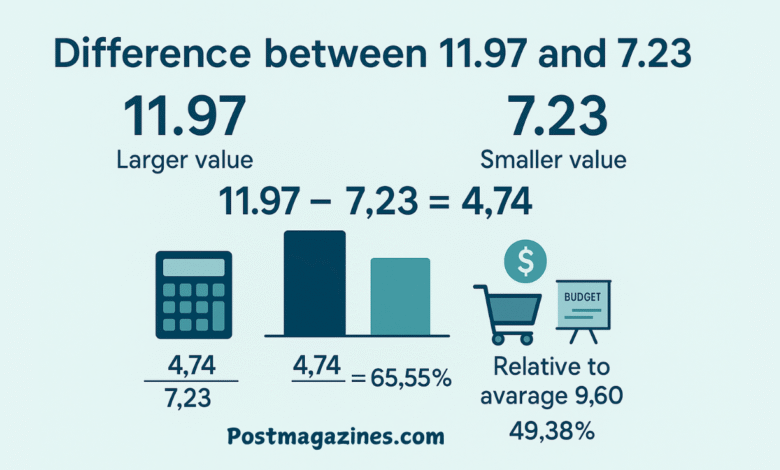What Is the Difference Between 11.97 and 7.23: A Complete Guide

Numbers play a crucial role in our daily existence. From calculating expenses to analyzing data, comparing two values helps us make informed decisions. One common type of question that arises is: what is the difference between 11.97 and 7.23? At first glance, this may appear to be a simple subtraction problem, but the concept has broader implications in mathematics, finance, business, and everyday problem-solving. In this detailed article, we will investigate the differences between these two numbers, break down the calculations, analyze the percentage difference, and explore real-life scenarios where such comparisons are relevant.
Understanding the Basics of the Question
When we ask what is the difference between 11.97 and 7.23, the direct mathematical operation is subtraction. In simple terms, we want to know how much larger 11.97 is compared to 7.23.
- Larger value: 11.97
- Smaller value: 7.23
- Operation: 11.97 − 7.23
The result of this calculation gives us the absolute difference.
Step-by-Step Calculation
- Start with the higher number: 11.97
- Subtract the lower number: 7.23
- Perform subtraction:
- 11.97−7.23=4.7411.97 – 7.23 = 4.7411.97−7.23=4.74
So, the absolute difference between the two numbers is 4.74.
This means that 11.97 is greater than 7.23 by 4.74 units.
Percentage Difference Explained
Sometimes, knowing the raw difference is not enough. We also want to understand the relative difference—how big that gap is compared to the original values. This is where the percentage difference comes in.
There are two common ways to calculate percentage difference:
Relative to the Smaller Value
11.97−7.237.23×100\frac{11.97 × 7.23}{7.23} \times 1007.2311.97−7.23×100=4.747.23×100≈65.55%= \frac = 4.74 7.23} \times 100 ≈ 65.55\%=7.234.74×100≈65.55%This means that 11.97 is about 65.55% larger than 7.23.
Relative to the Average of Both Values
∣11.97−7.23∣(11.97+7.23)/2×100\frac{|11.97 – 7.23|}{(11.97 + 7.23)/2} \times 100(11.97+7.23)/2∣11.97−7.23∣×100=4.749.60×100≈49.38%= \frac{4.74}{9.60} \times 100 ≈ 49.38\%=9.604.74×100≈49.38%Here, the percentage difference is around 49.38% when comparing relative to the average of the two numbers.
Why This Difference Matters
Now that we know the answer to what is the difference between 11.97 and 7.23 is 4.74, it’s essential to understand why such calculations matter in real life.
Financial Decisions
- Imagine two products in a store: one priced at $11.97 and another at $7.23. The difference of $4.74 may seem small at first, but if you are buying in bulk, the cost difference quickly adds up.
Budgeting
- Minor numerical differences can have a significant impact on monthly expenses. For instance, if two subscription services are priced at $11.97 and $7.23, the monthly difference is $4.74. Over the course of a year, this grows to more than $56.
Business Analysis
- Companies often compare sales figures, profits, or costs. Understanding whether the difference is 4.74 units or about 65% higher can determine investment or pricing strategies.
Visualizing the Difference
Another way to grasp what is the difference between 11.97 and 7.23 is by visual representation:
- Imagine a bar graph with two bars—one at 11.97 and another at 7.23.
- The gap between them is 4.74, which visually represents the numerical difference.
Such visual tools facilitate easier comparisons, especially in data-driven industries.
Real-Life Scenarios
Shopping Comparison
You see two similar products:
- Product A costs $11.97
- Product B costs $7.23
If you’re budget-conscious, knowing that the difference is $4.74 helps you decide whether the extra cost is justified by quality or brand value.
Academic Example
Teachers often ask students to compare numbers in math class. A question like what is the difference between 11.97 and 7.23 helps students practice subtraction, decimals, and percentages.
Salary Increments
Suppose an employee’s hourly rate increased from $7.23 to $11.97. The raise is not just $4.74 but represents a 65% increase, which is a significant boost in earnings.
Health and Fitness
If you track calories, comparing two meals with values of 11.97 grams of fat and 7.23 grams helps you evaluate dietary choices. The difference highlights the nutritional impact.
Breaking Down Decimal Comparisons
The numbers 11.97 and 7.23 are both decimals. Understanding their difference also helps students and professionals handle decimal operations confidently.
- The first decimal place (tenths) indicates the larger fractional value.
- The second decimal place (hundredths) gives precision.
When comparing decimals, subtraction ensures accuracy in areas like science experiments, recipe adjustments, and technical measurements.
Broader Applications
In Economics
Slight differences in percentages, such as interest rates shifting from 7.23% to 11.97%, can have a significant impact on loan repayments.
In Technology
Data scientists often measure performance differences between algorithms. A score changing from 7.23 to 11.97 may appear small, but in percentage terms, it reflects a notable improvement.
In Sports
Athletes’ statistics often use decimals. A performance rating of 11.97 compared to 7.23 highlights the significant skill gap.
Common Misconceptions
- It’s just a subtraction problem – While accurate mathematically, the implications in real-life scenarios are much more profound.
- Small numbers don’t matter – even a difference of 4.74 can accumulate over time or have a significant impact, depending on the context.
- Percentage difference isn’t essential – In reality, relative comparisons often matter more than absolute values.
Practical Tips for Understanding Differences
- Always calculate both the absolute and percentage difference.
- Use visualization tools (graphs, charts) to understand numerical gaps better.
- Apply the difference to real-life contexts (finance, business, health) for clarity.
- Remember that decimals represent precise measurements, so even slight differences can be significant.
Conclusion
What is the difference between 11.97 and 7.23? The straightforward answer is 4.74. However, as we’ve seen, the importance of this calculation goes far beyond subtraction. In percentage terms, the difference can be as high as 65.55%, depending on the method of calculation.



